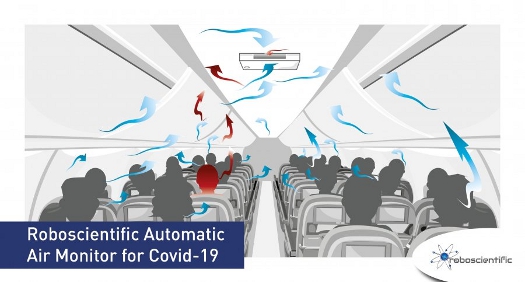 |
| August 17, 2021 | Volume 17 Issue 31 |
Designfax weekly eMagazine
Archives
Partners
Manufacturing Center
Product Spotlight
Modern Applications News
Metalworking Ideas For
Today's Job Shops
Tooling and Production
Strategies for large
metalworking plants
Sensors detect odor of COVID-19 infections with up to 100% accuracy
Does COVID-19 have a distinct smell? Researchers in England say that individuals infected with the SARS-CoV-2 virus have an identifiable odor -- and that new sensors they have developed can detect it with impressive accuracy.

Diagram depicting RoboScientific's automated COVID Air Monitor sampling the air to screen for the presence of COVID-19 infected travelers. [Credit: RoboScientific Ltd.]
Technology developed for COVID-19 detection and monitoring can distinguish between individuals infected with the SARS-CoV-2 virus and uninfected individuals from body odor samples with up to 100% accuracy, according to new research.
Led by researchers from the London School of Hygiene & Tropical Medicine (LSHTM) and the biotech company RoboScientific Ltd. with Durham University (also in England), the study tested devices with organic semi-conducting (OSC) sensors that could potentially be used as a COVID-19 screening tool.
The pre-print, which is not yet peer-reviewed, shows that COVID-19 infection has a distinct smell resulting from changes in the volatile organic compounds (VOC) that make up the body odor -- generating an odor "fingerprint" or signature that the sensors can detect.
This study used body odor samples from socks worn and donated to the team by 54 individuals: 27 COVID-19 positive individuals who were asymptomatic or had mild symptoms, and 27 uninfected individuals. These samples were analyzed by RoboScientific's Model 307B VOC analyzer fitted with an array of 12 OSC sensors.
The samples were collected as part of a wider study led by LSHTM, in collaboration with Medical Detection Dogs and Durham University.
The OSC sensors captured the odor profile of the samples, having been tuned to be sensitive to the VOCs associated with COVID-19 infection, primarily ketone and aldehyde compounds.
Over two days of testing the samples, the researchers found the sensors were able to distinguish between infected and uninfected samples, demonstrating that SARS-CoV-2 infection has a distinct smell. On the first day of testing, they achieved an average of 98% specificity (meaning a low risk of false positive results) and an average of 99% sensitivity (meaning a low risk of false negative results).
On the second day of testing, the sensors achieved 100% sensitivity and specificity, suggesting they can detect the presence of COVID-19 infection more accurately than any other diagnostic test available.
"These results are really promising and demonstrate the potential for using this technology as a rapid, non-invasive test with incredible accuracy," said Professor James Logan, head of the Department of Disease Control at LSHTM, who led the study. "However, further testing is required to confirm if these results can be replicated in real-world settings."
"If these devices are successfully developed for use in public places, they could be affordably and easily scaled up," he said. "They also could protect people against future disease outbreaks, with capability to develop sensor arrays to detect other diseases within a number of weeks."
Professor Steve Lindsay, from the Department of Biosciences at Durham University, added, "Many diseases have a distinct smell associated with them. We started our research with a blank sheet of paper and asked the question: Does COVID-19 have a distinct smell?
"We ended the research showing a clear separation between the odors of people infected with the virus and those uninfected. COVID most definitely has a very distinct smell. This is real discovery science and very exciting for the development of screening methods for the disease."
The Cambridgeshire-based start-up called RoboScientific is exploring the potential of two types of devices underpinned by these findings to enable fully automated COVID-19 screening: a portable handheld device and a room-based device.
The handheld device, developed from RoboScientific's existing technology for early disease detection, could detect if a person is COVID-19 positive from their body odor. If deployed in public spaces, these devices could be used in place of PCR (polymerase chain reaction -- RNA) and LFT (lateral flow testing -- antigen) testing as a faster, less invasive diagnostic to inform an individual whether they are infected and required to self-isolate. They can be used with a separate air sampler or individual breath or mask samples.
The room-based device, which is the first of its kind, could screen areas (such as classrooms or aircraft cabins) to detect if an infected individual is in the room, with air analysis results within an estimated 30 minutes. If COVID-19 positive odor is detected, all those in the room would need to be individually tested to determine who was infected, because the device would only detect the presence of infection, not who is infected. It would therefore not be designed to replace PCR or LFT testing, but rather for use alongside these strategies to allow more targeted testing, saving money and time, and reducing onward transmission.
These devices were developed by adapting technology previously used in chicken houses to detect disease in flocks of up to 50,000 chickens, using well-proven sampling methods and analysis.
"Our experience in consumer electronics, coupled with five years developing our unique sensors for agricultural applications, has enabled us to create a new way of sensing VOCs," said Stan Curtis, CEO of RoboScientific. "Our disease detection platform can provide fast, accurate screening for diseases so that we will be ready if/when the next pandemic arrives."
The researchers acknowledge limitations of this study, including the small sample size, so further research with larger sample sizes is required to refine the sensors. Additionally, testing on infected individuals is needed to ensure the effectiveness and accuracy of the devices carries over to real-world settings.
Source: London School of Hygiene & Tropical Medicine
Published August 2021
Rate this article
View our terms of use and privacy policy
